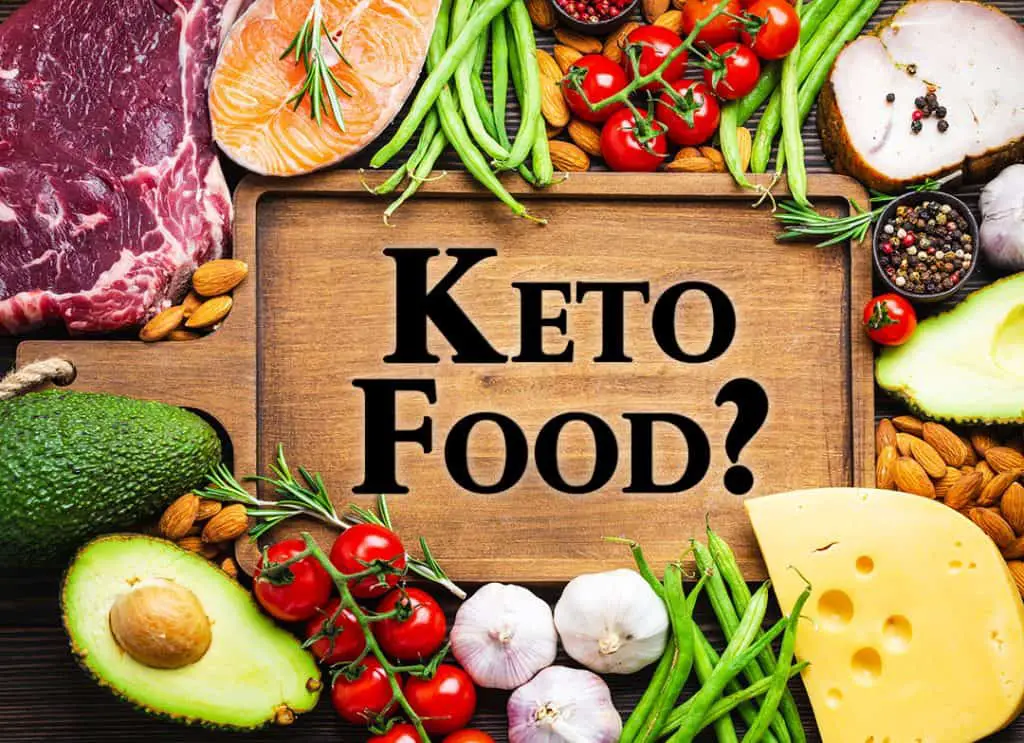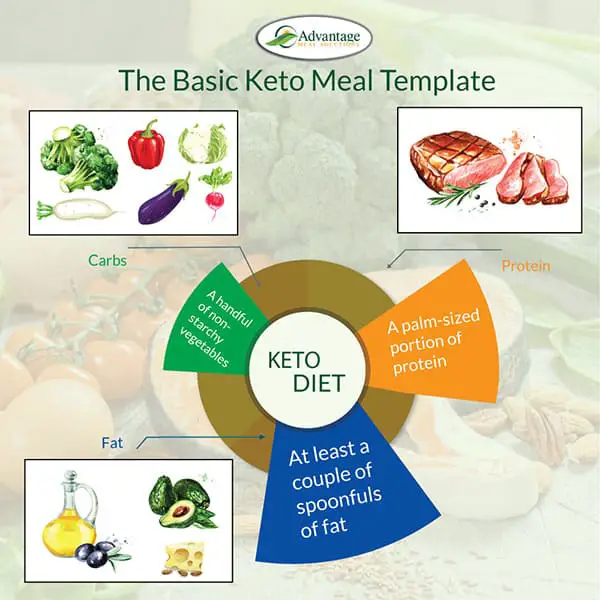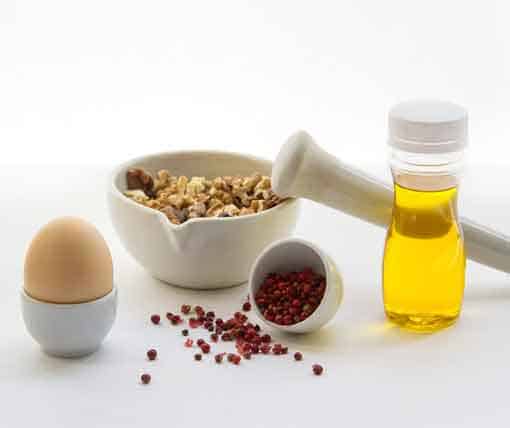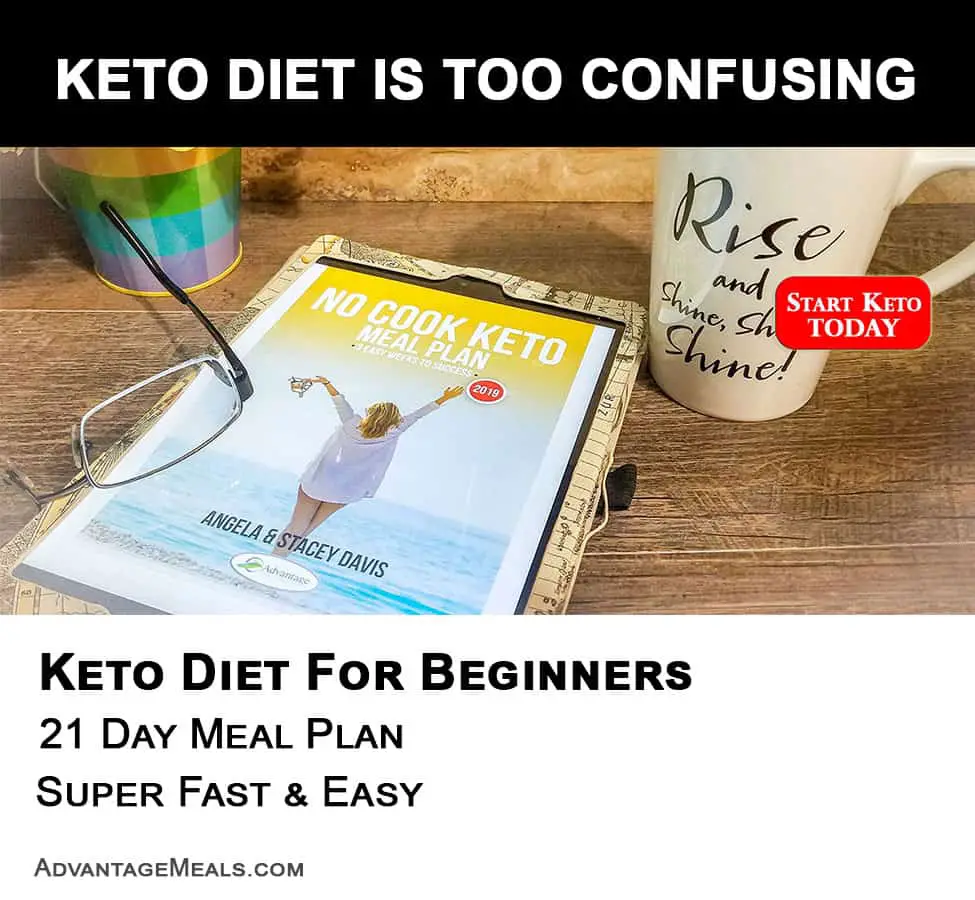
This site may contain links to affiliate websites, and we receive an affiliate commission for any purchases made by you on the affiliate website using such links.
On a ketogenic diet, you eat like royalty.
On a ketogenic diet, we enjoy the foods that our ancestors loved; good fatty meat, veggies and greens, and an occasional feast of sugar and carbs.
Before the insanity of the low-fat diet craze, a diet that was based primarily on grains and legumes was considered starvation food and only suitable for people trying to survive until the famine ended.
While the destitute subsisted on rice and beans, the wealthy ate meat that was cooked in fat and topped with fatty sauces, served with a side of fresh vegetables. That’s what we call wealth…”nutritional wealth”.
Do yourself a huge favor: Avoid focusing on what you can’t eat and instead celebrate all the delicious foods that are part of your new ketogenic way of eating!
As you begin your keto diet, the question to ask yourself is:
“What can I eat on a Keto Diet?”
Table of Contents
- Basic Keto Meal Template
- Thoughts On Eating Clean Keto
- Keto Proteins / Meat
- Keto Vegetables
- Keto Fats
- Keto Fruits
- Keto Sweeteners
- Keto Flour
- Keto Drinks
- Foods To Avoid On Keto
- Summary
The Basic Keto Meal Template
Keto meals do not need to be complicated.
At their best, they are often simple and straight forward, full of flavor because they feature satisfying fat, protein, and colorful vegetables.

My Basic Keto Meal Template is:
- A palm-sized portion of protein
- A handful of non-starchy vegetables
- At least a couple of spoonfuls of fat
If you keep this simple tool in mind when choosing what to eat on your new keto diet, you’ll be way ahead of your keto newbie peers.
P.S. For more on how the Basic Keto Meal Template works, read my article that talks all about it!
Thoughts on Eating Clean Keto
Here at Advantage Meals, we promote a clean, real food approach to Keto.
But everyone is in a different place on the journey, with different backgrounds, goals, and needs. You may find that including a few processed foods here and there helps you stick to your goals, and that’s ok.
We even include some processed foods in our No-Cook Keto Meal Plan, designed to be the easiest keto meal plan available for the keto newbie. { Click here to learn more about my Keto Meal Plan. >>> }
Stick to whole foods when you can and use processed foods if you need to when first getting started. As you get used to eating Keto, you can upgrade your food once you are past the stress of changing the way that you eat!
Below I’ve made a number of keto food lists to help understand what food is good for getting into and staying in ketosis, while supporting your health along the way.
Our keto food lists include:
At the beginning of each section you’ll find a brief discussion about how each food group fits into your new ketogenic diet, then we’ll give you a nice table of good keto choices in that group.
Keto Protein / Meat
Keto is a way of eating that includes a moderate amount of protein that your body needs to maintain or grow muscle mass.
One of the best things about the keto diet is that you can now enjoy the more flavorful cuts of meat without experiencing the guilt that came with the low-fat guidelines of the Standard American Diet (we refer to it as the SAD Diet).
So no more lean, dry cuts of meat! Instead, you are going to be enjoying the fattier, full-flavored (and often less expensive) cuts of meat.
As I talked about in the clean keto section of this article, I encourage you to seek out the highest quality meat (organic, grass-fed, wild-caught) that you can afford. Higher quality meat has more nutrition and is more satiating because of those nutrients.
On the other hand, if your budget doesn’t allow high quality protein choices, stick with the lower cost options.
List of Keto Meat & Other Protein Choices
| Protein | Keto Notes |
|---|---|
| Eggs | For our money (and yours!) eggs are one of the best, most affordable protein choices available. With both protein and fat, ease of use, flexibility, and cost, eggs are a great choice. Free-range is best, with significantly higher vitamin and mineral content than conventional eggs. Bonus points if you buy them from a local farmer at the farmer’s market! |
| Fish | Especially fatty fish like salmon, herring, mackerel, and tuna (fresh or canned), due to their high omega-3 content. Wild-caught is best. Other great sources of omega-3 that are also low in harmful mercury since they are lower on the food chain include sardines, anchovies, and kippers, and they are all available very affordably in cans. Leaner fish are fine, too. You’ll just want to make sure you add fat in the form of sauce, cheese, oil, butter, etc. Catfish, tilapia, cod, and pollock, to name a few. |
| Shellfish | Shrimp, mussels, crab, lobster, oysters are all on the menu. Dip them in grass-fed butter and enjoy! |
| Beef | Steak, especially fattier cuts like ribeye, roast, ground beef (use the higher fat variety, such as 80/20). |
| Pork | Roasts, chops, ribs, whole loin. |
| Poultry | Chicken, Turkey, Duck, Goose – they’re all good. Duck and goose tend to be fattier and more nutrient-dense in general, and they render some really great fat that can be used for cooking. Dark meat has more fat and flavor, and leave the skin on when roasting! (I’ve even saved the skins and roasted them separately with a little olive oil and salt to make chips – yum!) Thighs, drumsticks, and wings are all great. Breast is fine, too, just make sure to add fat. |
| Lamb | Roasts, chops, ribs. |
| Organ Meats | Often forgotten in modern culture, organ meats have a huge advantage over muscle meats when it comes to nutrient density. They also tend to be more affordable. Organs are the filters of the body, though, so finding clean, well-raised sources are even more important. Try liver, heart, and gizzards to start. |
| Processed and Cured Meats | Sausage, ham, bacon, pepperoni, salami. Almost all have higher fat content but they also often contain additives, chemicals and may include sneaky sugar. Make sure to buy carefully and read labels looking for any added sugar. |
| Bone Broth | Save the bones from your meats and toss them in a crockpot to make your own bone broth. High in the kinds of protein that encourage a healthy gut, along with great skin and hair. Many people find that bone broth helps with the symptoms of keto flu. If you are not in a place to make your own bone broth, then buy the highest quality that fits your budget such as those from The Osso Good Company. |
Keto Safe Vegetables
Next on your plate, you are going to add amazing veggies that are low in net carbs. (Total carbs minus fiber equals net carbs.)
Vegetables that grow above ground have less carbs. Steer clear of vegetables that grow below ground, grains and legumes.
This is not an exhaustive list, but these are some great choices that you can find in most grocery stores. Fresh or frozen are great, but avoid canned vegetables.
If you are eating whole foods and avoiding processed foods, vegetables will make up the majority of your carbohydrate intake on Keto. Most of these are low in carbs, but you still need to count the net carbs in vegetables, just like anything else that has carbs.
Some veggies have more carbs than others. Take note of the items near the bottom of the list, as they might surprise you. Watch your portion size on all!
If you are taking longer to get into ketosis than you expected, be careful with veggies like Brussels sprouts, tomatoes, green beans, cabbage and artichoke hearts as their carbs can add up. Be vigilant about watching your portion sizes!
List of Keto Friendly Vegetable Choices
| Keto Vegetable | Serving Size | Approximate Net Carbs |
|---|---|---|
| Artichoke Hearts – Whole and Cooked | 1/2 Cup | 5 Net Carb |
| Asparagus – Cooked | 1/2 Cup | 2 Net Carb |
| Bell Peppers – Green Fresh Raw | 1/2 Cup | 1 Net Carb |
| Bell Peppers – Red Fresh Raw | 1/2 Cup | 3 Net Carb |
| Bell Peppers – Yellow Fresh Raw | 1/2 Cup | 4 Net Carbs |
| Broccoli – Cooked Florets | 1/2 Cup | 2 Net Carbs |
| Brussels Sprouts | 1/2 Cup | 3.5 Net Carbs |
| Cabbage – Red or Green Shredded & Cooked | 1/2 Cup – | 3 Net Carbs |
| Cabbage – Slaw Mix Shredded & Raw | 1/2 Cup | 2 Net Carbs |
| Cauliflower – Cooked Florets | 1/2 Cup | 2 Net Carbs |
| Celery – Raw | 2 Medium Stalks | 1 Net Carb |
| Collard Greens – Cooked | 1/2 Cup | 3 Net Carbs |
| Cucumbers – Raw & Sliced | 1 Cup | 3 Net Carbs |
| Garlic – Raw | 1 Clove | 1 Net Carb |
| Green Beans – Cooked | 1/2 Cup | 3 Net Carbs |
| Kale Greens – Cooked | 1/2 Cup | 3 Net Carbs |
| Mushroom – Button Mushrooms Cooked | 1/2 Cup | 2.5 Net Carbs |
| Mushroom – Portobello Mushrooms Cooked | 1/2 Cup | 3 Net Carbs |
| Okra – Sliced & Cooked | 1/2 Cup | 1.5 Net Carbs |
| Onion | 1/4 Cup | 3 Net Carbs |
| Radish | 1/2 Cup | 1 Net Carb |
| Spinach – Chopped & Cooked | 1/2 Cup | 1 Net Carb |
| Spinach – Fresh & Raw | 3 Cups | 1 Net Carb |
| Swiss Chard Greens – Chopped & Cooked | 1/2 Cup | 1 Net Carb |
| Tomato – Fresh & Raw | 1/2 Medium | 3 Net Carbs |
| Tomato – Diced & Cooked | 1/2 Cup | 4 Net Carbs |
| Turnips | 1/2 Cup | 3 Net Carbs |
| Yellow Squash – Sliced & Cooked | 1/2 Cup | 2 Net Carbs |
| Zucchini – Sliced & Cooked | 1/2 Cup | 2 Net Carbs |
Keto Approved Fats
One of the best parts of a Keto diet is that fat is not only included, it’s vital!
Eating fat in the absence of carbohydrates helps your body recognize that you want to switch your primary fuel source to fat. Once you are fat-adapted and good at burning fat, your body will begin to burn its own stored fat for fuel.
When that happens, you’ll soon be experiencing effortless weight loss if you are doing keto right.
When starting your keto diet, calories from fat is going to make up 60% or more of your total calories, and many keto newbies struggle to get enough fat into their diet but if you have a wide variety of good fat sources, hitting your target fat macro will soon be easy.
You can add good fat to those amazing proteins and vegetables while cooking and in the form of keto dressings, sauces, or dips when you are ready to eat. I’ve got lots of ideas to get you started in my Fat Boosters article.
The fats you use as part of your ketogenic diet need to be natural and unprocessed so your body recognizes them as fuel.
Avoid fake and industrially processed fats like trans fats, hydrogenated oils, margarine, corn oil, soybean oil, canola oil, and vegetable oil. We’ll cover this in much greater detail later in this article.
List of Good Keto Fat Choices
| Keto Fat | Keto Notes |
|---|---|
| Butter | Choose the highest quality butter that fits your budget. We look for grass-fed, pastured butter first. If unavailable, we look for conventional organic butter. Also consider Ghee, which is clarified butter; it’s flavor is wonderful! |
| Olive Oil | We look for Extra Virgin Olive Oil which is the least processed option for Olive Oil. However, lower quality olive oil is still better than all conventional seed oils. |
| Avocados | Avocados are a staple for most people who follow the ketogenic diet. Remember that you don’t have to eat raw avocados all of the time. Guacamole is a great way to eat avocado! |
| Avocado Oil | Avocado oil is a super high-quality oil and you should find ways to add it to your diet. It’s good to cook with, and not bad on salad once you get accustomed to the taste of avocado. |
| Coconut Oil | Coconut oil is one of nature’s best non-animal fats (avocado is the other). It does add a slight flavor of coconut, so we don’t use it to cook everything, but we do like it with seafood. |
| Coconut Milk | Just another variant of the great fat found in coconuts. We use coconut milk in curries a lot. |
| Coconut Butter | Thicker than coconut milk, coconut butter is used in lots of fat bomb recipes like these Chocolate Coconut Fat Bombs. |
| Cheese | Choose full-fat high-quality cheese and enjoy it! |
| Rendered Fat | We save the rendered fat from cooking bacon, duck, goose, beef tallow. You can also buy some great rendered fat or lard, just make sure you’re getting high-quality real lard and not hydrogenated stuff. |
| Mayonnaise | Mayonnaise is a pretty standard fat for most people, and adding a little more of it is an easy way to hit your fat macro goal. If it fits within your budget, get high-quality mayonnaise-like those made with avocado oil. { Click to see our favorite on Amazon. >>> } |
| Olives | Eating olives is a good way to add more fat to your new keto diet. |
| Nuts | Eating nuts is also a good way to add more fat to your diet. Just choose your nuts carefully. Macadamias are great because they have the least amount of omega 6, which can be inflammatory. Almonds, walnuts, brazil nuts are also good. Pumpkin seeds, sunflower seeds, and pistachios are good. Make sure all are not roasted in processed seed oils. Peanuts and peanut butter are good for some people – see how they work for you. Check the labels carefully and make sure any nut butters you eat do not have added sugars. |
| Heavy Whipping Cream | A great source of fat for your coffee and it’s yummy! |
| Cream Cheese | Cream cheese is a great low-carb & high-fat base for countless dips and toppings. |
Keto Approved Fruit
For many who have been trying to “eat right” on the Standard American Diet (SAD), learning that most fruit is not keto friendly is a shocker.
While the saying goes “An apple a day keeps the doctor away”, the carb count in that apple will also keep you from getting into ketosis or keep you from staying in ketosis. Yes, eating a whole fruit is better for you then just drinking the juice, but it’s still sugar even if it is natural sugar.
You can have some fruit on a keto diet, but you have to eat small portions and pay close attention to the carb counts. The following low sugar fruits can be enjoyed in moderation.
Once you hit your goals, if you want to eat fruit seasonally, give it a try and see how your body reacts. But as you are trying to begin your keto diet, avoid all fruits except for the following shortlist keto fruits.
List of Good Keto Fruit Choices
| Keto Fruit | Serving Size | Approximate Net Carbs |
|---|---|---|
| Blackberries – Raw | 1/2 Cup | 3 Net Carbs |
| Blueberries – Raw | 1/2 Cup | 8 Net Carbs |
| Lemons – Juice | 1 tbsp | 1 Net Carb |
| Limes – Juice | 1 tbsp | 1 Net Carb |
| Raspberries – Raw | 1/2 Cup | 3 Net Carbs |
| Strawberries – Raw & Sliced | 1/2 Cup | 4 Net Carbs |
Remember that a lot of things we think of as vegetables are actually fruits! Here are some other ‘vegetables’ that are actually great low carb fruit choices. Bonus – these are also great fat sources!
- Avocado (1/2 medium, 1.5 net carbs)
- Coconut (2 tbsp coconut butter, 3 net carbs)
- Olives (5 medium black olives, 1 net carb)
Some of the confusion between vegetables and fruits are so ingrained that we actually listed them in the keto veggies, those include:
- Tomatoes
- Squashes
- Cucumbers
- Bell Peppers
We use both fresh and frozen fruits and vegetables but we avoid canned. Organic is best, but buy what makes the most sense for your budget.

Keto Sweeteners
There are some sweeteners you can include in a Keto diet, to sweeten your coffee or tea or to make low-carb desserts and treats.
A little sweetness is a must for most people, at least occasionally. With that in mind, below is a list of our favorite keto sweeteners that are all near-zero or zero carb sweeteners.
You will find in time that your taste for sweets diminishes and you will need less and less, but particularly when you first start, it is nice to have a way to still include sweet-tasting treats.
These can be a little hard to find in your local grocery store, so I’m including a link to each on Amazon. In full disclosure, these are affiliate links where we make a little money when you make purchases through these links at not cost to you.
List of Good Keto Sweeteners
| Keto Sweetener | Keto Notes | Where To Buy |
|---|---|---|
| Erythritol | A zero-calorie sweetener that can be used as a 1 to 1 sugar substitute in recipes. | See On Amazon |
| Monk Fruit Extract | Made from Monk Fruit and over 100x sweeter than table sugar. | See On Amazon |
| Stevia | A zero-calorie sweetener made from the Stevia Plant. | See On Amazon |
| Swerve | A mixture of Net Zero Carb Sweeteners designed for baking. | See On Amazon |
Keto Baking Flour
Keto baked goods are incredibly popular, as they give people the experience and/or feeling of eating beloved favorites from their old way of eating.
There are recipes all over the internet for Keto bread, pancakes, cookies, and much more.
These familiar treats can definitely be helpful as you transition to a Keto way of eating. If you are craving something, find a way to make yourself a Keto version.
Just watch that these treats don’t become a staple in your diet. They are more processed than simple meat and vegetables, and they can be habit-forming, just like their higher carb versions.
Keep in mind that these are lower-carb versions of your old treats, but the are not zero-carb. If you eat too many of these your keto diet will not be successful.
As you adjust to Keto, you’ll find that your tastes change and you’ll crave them less and less.
When you want a treat, you’ll probably find these flour alternatives in a lot of recipes. Since some of these are hard to find in your local grocery store, I included a link to each on Amazon. In full disclosure, these are affiliate links meaning that Amazon pays us a small commission when you make a purchase through our links.
| Keto Flour | Net Carbs Per 2 Tbsp | Notes |
|---|---|---|
| Coconut Flour | 3 Net Carbs | Used in lots of sweet keto baked treats. |
| Almond Flour | 2 Net Carb | Used in most savory keto breads, like our Keto Garlic Bread Recipe. |
| Flax Meal Flour | 1 Net Carb | A general-purpose keto flour. |
Keto Drinks
Giving up high carb drinks is often one of the hardest things for people to adjust to when starting a ketogenic diet.
This is because the most common drinks in a Standard American Diet (SAD) are keeping you in a constant glycemic state and will absolutely keep you from transitioning to ketosis unless you entirely eliminate drinking sugar.
Common sugary drinks that must be eliminated include; non-diet soda, juice, most beer, sweet tea, most energy drinks, and sweetened coffee creamers.
List Good Keto Drinks
- Water
- Iced Tea
- Hot Tea
- Sparkling Water – Sugar-Free
- Coffee
- Sugar-Free Energy Drinks like Red Bull
Sparkling waters are nice because they have carbonation and a little bit of flavor. Make sure there is no sugar added – some brands do but many do not.
Coffee is fine, as long as you don’t add sugar to it. Most creamers are full of additives and, you guessed it, sugar. So if there are carbohydrates included on the nutrition label, avoid it and go for the good stuff…real heavy whipping cream.
Hot Tea is great. Iced Tea is too. Sweet Tea is not ketogenic.
If you must have sugar free soda, do it. We don’t think you are doing your health any favors with the artificial sweeteners, but most won’t keep you from being in ketosis.
Keto Adult Beverages and Keto Cocktails
You can have a drink and stay in ketosis if you choose wisely and drink in moderation.
Keep in mind the calories in the alcohol that you drink, because your body will burn those alcohol calories first, before carbs, fat or ketones, so drinking will put weight loss efforts on hold.
Alcohol also lowers your impulse control, so be vigilant about avoiding old eating habits if you choose to have a drink.
Pure unflavored distilled liquor has zero carbs and can be included on a ketogenic diet.
Dry wines are also low carb.
Some beers are lower carb.
List of Good Keto Alcohol Choices
| Keto Alcohol | Approximate Net Carbs | Approximate Calories/Serving |
|---|---|---|
| Brandy | 0 Net Carbs | 65 Calories |
| Gin | 0 Net Carbs | 65 Calories |
| Tequila | 0 Net Carbs | 65 Calories |
| Vodka | 0 Net Carbs | 65 Calories |
| Whiskey | 0 Net Carbs | 65 Calories |
| Dry Wine (Red or White) | 2 Net Carbs | 110 Calories |
| Dry Sparkling Wine | 2 Net Carbs | 80 Calories |
| Low Carb Beer | 3 Net Carbs | 60 Calories |
If you use a mixer besides water, make sure it is sugar-free. Even if you start with zero-carb alcohol, mixing with juice or sugary soda will make it very high-carb.
Even some tonic waters are packed with sugar. To learn more about choosing a good keto tonic water, check out this article we wrote.
Regular (Non-Light) beer is a definite NO during a keto diet as it’s going to range from 10 net carbs to over 50 for some big malty craft beers.
However, there are some pretty decent low-carb beer options out there. If you go this way, just make sure to do so in moderation.
List of The Best Keto Beers
| Keto Beer Brand | Net Carbs | Alcohol Content | Calories |
|---|---|---|---|
| Budweiser Select 55 Lite Lager | 1.9g Carbs | 2.4% ABV | 55 |
| Miller Genuine Draft 64 Light Lager | 2.4g Carbs | 2.8% ABV | 64 |
| Michelob Ultra | 2.6g Carbs | 4.2% ABV | 95 |
| Beck’s Premier Light | 3.2g Carbs | 2.3% ABV | 64 |
Be smart and safe with alcohol. When on a keto diet, most people find that their alcohol tolerance is significantly lower.
What Foods Should I Avoid On a Keto Diet?
There are some foods that you will be eliminating while following a strict ketogenic diet. It may seem a bit daunting, but keep reminding yourself of all of the great things that you can eat on your Keto Diet!
The most important part of a Keto diet is keeping your carb intake very low. To be in ketosis and stay there, you must avoid high carb food and drink.
I recommend that you keep your total daily carb intake below 25 net grams (Net Carbs = Total Carbs – Total Fiber) when starting a ketogenic diet.
Most of the foods on this list have close to 25 net carbs in just one serving, so it’s best to just avoid them completely.
List of Food Groups To Avoid or Eliminate on a Keto Diet
| Foods To Avoid | Keto Notes |
|---|---|
| Sugar | Look at every label for every kind of sugar. Don’t eat sugar, and don’t drink sugar! |
| Grains | All grains are high-carb; avoid them. |
| Beans | Beans are high carb. |
| Starchy Vegetables | Things like carrots and potatoes are starchy and packed with carbs. |
| Sugary Fruits | Most fruits, except for berries, are too high in sugar for a keto diet. |
All of these food groups are high in carbohydrates, and keeping your carb intake low (between 20-50 net grams) is vital to being in ketosis. You must deprive your body of carbs so that it can make the transition to burning fat.
List Of Specific Foods to Eliminate On A Keto Diet
The following is a list of specific yet common foods that are not part of your new ketogenic lifestyle because consuming a normal serving of them will knock you right out of ketosis.
Common Drinks to Avoid on a Keto Diet
- Soda / Soft Drinks
- Fruit Juice
- Beer
Common Grains to Avoid on a Keto Diet
- Pizza
- Hamburger buns, bread, crackers
- Pasta
- Chips
- Tortillas
- Wheat, rice, oatmeal, corn, quinoa
Common High Sugar Foods to Avoid on a Keto Diet
- Many Salad Dressings
- Steak Sauce
- Ketchup
- BBQ Sauce
- Fancy Coffee
- Jelly
- Honey, maple syrup
- Most fresh fruits
- Fruit Juice (or any ‘juice’ that tastes sweet)
- Dried fruits
- Processed foods – Anything that has an ingredient list needs to be checked carefully – it seems like they add sugar to everything!
Common Starchy Foods to Avoid on a Keto Diet
- French fries
- Potato chips
- Mashed potatoes
- Sweet potatoes
- Beans
Bad Fats to Avoid On A Keto Diet
Fats are very important on a ketogenic diet, and they make up anywhere from 65-90% of your daily calorie intake. In our decade-plus of experience, we have found that most people who are trying to achieve dramatic changes average around 70% of their daily calories from fat.
If a third or more of your calories are coming from fat, it becomes self-evident that the quality of that fat is very important.
Not all fats are created equal.
Natural, unprocessed fats are your friend.
Fats that have been highly processed and altered are dangerous in our bodies and make it difficult to experience all of the health benefits of a ketogenic lifestyle.
Below we’ve created a list of the most common damaged fats in a Standard American Diet.
Read your food labels carefully to watch for these damaged fats. The more of these highly processed fats you can avoid, the better your results will be on your ketogenic diet.
Common Bad / Highly Processed Fats To Avoid On Keto
- Canola Oil
- Margarine
- Sunflower Oil
- Vegetable Oil
- Corn Oil
- Soybean Oil

If you want a list of good keto fats, go back to our keto fat list above in this same article.
“What can I eat on a Keto Diet?” – Sum It Up
The best part about a keto lifestyle is that you can eat such rich and flavorful foods while getting healthier.
We encourage you to focus on the wonderful foods that you can eat while supporting your decision to better your health with Keto.
Keep the goals that made you start keto at the forefront of your mind when you choose what to eat and drink each day on your keto journey.
Revel in the fact that heavy whipping cream, butter, steak, and bacon are not just allowed on your keto diet, but are encouraged as keto superfoods!
Keto On! You got this, and we got your back. If you have any questions, don’t hesitate to contact us.
~Angela


